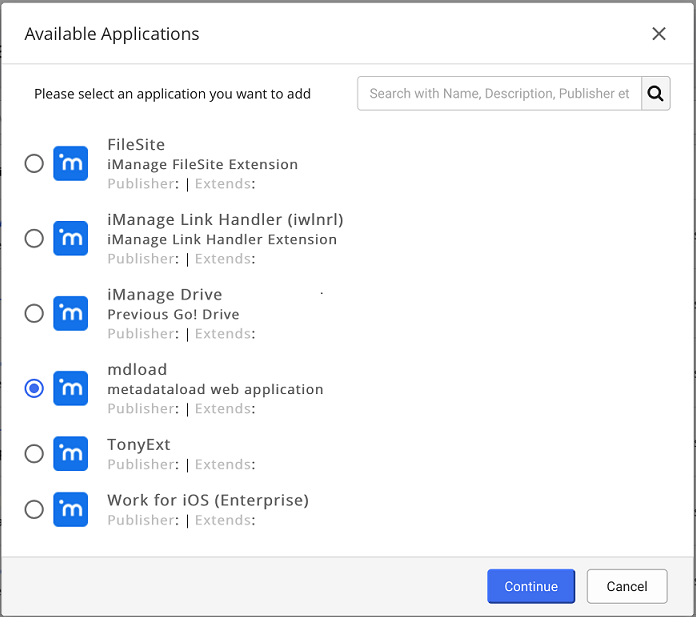Applications
Applications (also called apps in the iManage v2 API) are software packages that either integrate with iManage Work to access data from it, or extend the functionality of iManage Work client applications. For example, a firm may use an application for document comparison. In this case, the document comparison can extend iManage Work application by appearing as a context menu command on documents.
These applications are either developed by iManage, third-party vendors, or a company's internal development staff.
iManage Work Server 10.2 and later supports OAuth 2.0 authorization framework for the applications. Following are some of the benefits of OAuth 2.0:
It is an open standard for authorization and anyone can implement it.
It simplifies the authorization and access to iManage Work data while protecting the user's credentials.
It standardizes and secures the information sharing between iManage Work and other applications.
It works over HTTPS and authorizes the applications with access tokens rather than user credentials. This token is obtained by the client application before making the request and represents the user on whose behalf the the client application makes the request.
Any custom development with iManage Work APIs must be registered as a client application, and the developers can add customizations only through these registered client applications recognized by iManage Work. This is similar to using Facebook APIs as an example. If you are calling a Facebook API in your application, then Facebook must identify your application as an authorized client. Therefore, your application must be a registered client on Facebook. In iManage Work, these applications are uploaded and registered by iManage Work system administrators using Applications feature in iManage Control Center. The application which connects to iManage Work Server needs to be authorized using OAuth 2.0 authorization framework. The applications which do not connect to iManage Work Server may not need authorization. For example, an application that reads matter properties such as matter ID, matter name, custom1, and custom2 from iManage Work to display or further use them in the application . When invoked from a context menu, the application can access these properties from the application context without completing the authentication process . This application would only access data from iManage Work and does not require authentication.
Types of Applications
Applications feature enables you to manage the following types of applications:
iManage applications - These applications are developed by iManage and are available for iManage Work client applications. For example, iManage Work Desktop for Windows, iManage Work Email Management for Gmail, iManage Work Desktop for Mac, Mobility for iOS, and so on.
Third-party applications - The applications available from third-party vendors are of two types:
Standalone applications that interact with iManage Work through only APIs to access the information and do not modify its UI. For example, an application that tracks and analyses audit records of documents in iManage Work to understand user behavior.
Applications that extend iManage features and modify the UI by providing right-click menus or new panels in the the following applications:
iManage Work
iManage Work Desktop for Windows
iManage Control Center
You can also define security settings on these applications to make them available only to specific users.
Registering an Application
An iManage system administrator uploads the extensions or applications to the App store. These are then made available to the customer administrator to add through App store in iManage Control Center.
The third-party application developers or internal developers provide an application as a zipped package. To install this application:
A manifest package must be provided. This is a zipped file containing two files: A manifest file, manifest.yaml, that contains the information about client application, and a menu file, named like projectname.yaml, that contains information about displaying the item within iManage Work. For more information on the format and contents of manifest file, see Extensions for iManage Work in iManage Work V2 API Developers Guide.
Configuring an Application
Click CONFIGURE > System Setup > Applications. The list of applications registered by iManage cloud administrator appears.
Click
 to register a new application. The Available Application dialog appears.
to register a new application. The Available Application dialog appears.Figure: Available Application

Choose an application, and click Continue to configure the Security settings.
You can secure an application to selected users in the organization. This is helpful when you have a pilot group who is testing a new functionality, or if you have an application that is specifically meant for a certain users, for example, an application that tracks patent deadlines that only an IP group uses.

Select one of the following application access options.
All users - Select this option to provide access to all the available users.
Specific users/groups - Search and add the specific users and groups to provide the access.
The Enable flag set on the Configuration screen makes it available only to the users/groups you have added here.
Click Save and your application is registered successfully.
If you want to configure context menus, perform the steps provided at CLIENT SETUP > Web > Context Menus section.
Additional Actions on Applications
You can change or delete an application, and update its configuration details, authentication details, or security settings, if your third-party application vendor provides a new version of an existing application, or the authentication details for an existing application changes.
Disabling the application - You can also disable the package by selecting Enable as No on Configuration page.
Editing the properties - Update the specific properties by clicking Configuration , Authentication , or Security. You should change the authentication details only if the application vendor or internal application developer instructs you to do so.
Deleting the application - In the Applications list, select
 under Action, and click Remove.
under Action, and click Remove.